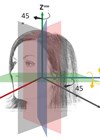
Cinema is reshaping how we see cochlear implants – raising awareness, sparking conversation and showing the power of representation.
Cinema wields immense power in shaping societal perceptions and sparking dialogue around medical and social issues. In the realm of hearing loss, films increasingly spotlight cochlear implants (CIs) and the experiences of those who are deaf or hard of hearing, broadening public understanding and empathy.
This article explores key cinematic portrayals of cochlear implantation, the impact on societal views and the medical, ethical and cultural dimensions underpinning these discussions. It also integrates perspectives from people with lived experience of deafness, both within the culturally Deaf community and others with lived experience of deafness and their families.
Cinema serves as a bridge between hearing and non-hearing worlds, humanising the journeys of characters with hearing impairments and fostering empathy. Studies show that positive media representation helps counter misconceptions about hearing loss and supports social acceptance of interventions such as CIs [1-3].
Notable films featuring cochlear implants
Sound and Fury (2000)
Production: Directed by Josh Aronson, released by Public Policy Productions.
Overview: Follows two brothers from a family with hereditary deafness. One considers CIs for his newborn son, while the other’s daughter also contemplates implantation.
Impact: Addresses the ethical debates around CIs and cultural identity. Highlights tensions between technological advancements and Deaf culture, as well as familial decision-making.
Step Brothers (2008)
Production: Columbia Pictures, directed by Adam McKay.
Overview: A comedy where an early scene references CIs and a Cochlear name badge, though it is not a pivotal storyline.
Impact: Even minor on-screen mentions can raise awareness, reminding viewers that CIs are part of everyday life for many.
Take Shelter (2011)
Production: Hydraulx Entertainment, written and directed by Jeff Nichols.
Overview: A psychological thriller about a father with apocalyptic visions, featuring a subplot of his six-year-old daughter receiving a CI.
Impact: Underscores the emotional and logistical issues families face when a child undergoes CI surgery, even though the implant is secondary to the main narrative.
A Quiet Place (2018)
Production: Produced by Platinum Dunes and Paramount Pictures, directed by John Krasinski.
Deaf actor: Millicent Simmonds, who is deaf in real life, portrays Regan.
Overview: In a post-apocalyptic setting where sound can be fatal, Regan’s CI and her use of sign language are vital to family survival.
Impact: Showcases the strengths and vulnerabilities of relying on a CI. The authenticity is heightened by Simmonds’ involvement, reflecting her lived experience.
Battle (2019)
Production: Russian-language film directed by Anar Abbasov.
Overview: A talented street dancer loses his hearing and adapts with the help of a CI, eventually teaching dance to deaf children.
Impact: Illustrates how CIs empower individuals, highlighting community support as a key factor in alleviating isolation.
Toy Story 4 (2019)
Production: Pixar Animation Studios and Walt Disney Pictures.
Overview: Features a brief scene of a child with a bright green CI processor.
Impact: Normalises hearing devices for children. Families praised the inclusive portrayal, noting that it helped children with CIs feel represented.
Sound of Metal (2020)
Production Director: Amazon Studios, directed by Darius Marder.
Overview: Centres on Ruben, a drummer who loses his hearing and contemplates CIs.
Impact: Known for immersive sound design that draws viewers into Ruben’s auditory experience. Highlights the psychological and social disruptions caused by sudden hearing loss.
Soundless (2020)
Production Director: Persian film by Behrang Dezfulizadeh.
Overview: Depicts a hearing-impaired mother who wants her child to hear through CIs, while the deaf father wishes the child to remain deaf.
Impact: Examines family tensions in navigating cultural identity and modern technology. Shows how societal prejudice and personal convictions influence these decisions.
Sonata (2021)
Production: Polish film directed by Bartosz Blaschke.
Overview: True story of Grzegorz Plonka, initially misdiagnosed with autism. A CI uncovers that his isolation was due to hearing loss and reveals his musical talents.
Impact: Demonstrates how timely diagnosis and intervention can transform lives, reinforcing the ability of CIs to reduce isolation and unlock potential.
Television shows
Fear the Walking Dead (2015–2023)
Features Paul (played by actor Wawa, who is deaf), relying on a CI to communicate and survive in a zombie-infested landscape.
Sex Education (2019–2023)
Introduces Aisha, a high school student who is deaf and a CI user, illustrating the struggles and triumphs of teenage life in a hearing environment.
Influence on public awareness and perception
Destigmatising hearing loss
Research confirms that societal stigma can be a major barrier to CI uptake [1-3]. By depicting CI users as multidimensional people, films such as Sound of Metal and Toy Story 4 help counter negative stereotypes and reduce stigma.
Understanding CI technology
Research shows that misconceptions, like believing CIs are invisible or constantly need replacement, can discourage potential users [1,4,5]. Cinema clarifies the procedures and adaptations linked with CIs. Sound of Metal’s soundscapes convey the confusing shift from typical hearing to implant-mediated hearing.
"Cultural debates, such as parents choosing CIs for children or balancing tradition with technology, remain rich terrain for thoughtful storytelling"
Family and community engagement
Studies indicate that family involvement and robust community resources are instrumental in successful CI usage [1,6-9]. Plotlines featuring strong family support, as seen in Take Shelter and Battle, illustrate how positive social networks assist in easing the transition.
Mental health and isolation
Films such as Sound of Metal highlight the emotional toll of hearing loss, including depression and anxiety. Increased awareness encourages policymakers and clinicians to integrate psychological care into CI programmes [1,6,10,11].
Driving advocacy and policy
Research shows that disparities like socioeconomic inequity affect CI uptake [1,6-8]. Prominent portrayals of hearing loss can galvanise advocacy efforts, prompting health authorities to address issues of access, affordability and insurance coverage.
Ethical and cultural considerations
It is vital to represent a range of perspectives from those with lived experience of deafness – both within and outside the culturally Deaf community. Films like Sound and Fury or Soundless portray conflicting views about preserving a Deaf identity versus embracing technology. Balancing cultural identity with individual autonomy is a complex undertaking that resonates in both clinical and ethical spheres [1,4,5].
Authenticity also depends on including deaf actors and consulting people who have personal experience of deafness. Millicent Simmonds’ role in A Quiet Place illustrates how genuine representation enhances impact and fosters empathy.
Suggestions for future filmmaking
Collaboration
Consulting those with different forms of deafness and varied backgrounds leads to more accurate portrayals, countering stereotypes [1,4,5].
Diverse narratives
Expanding stories to encompass multiple social and economic contexts can spotlight the structural barriers identified in research [1,5,12].
Educational components
Inserting short factual segments or post-credit materials can combat myths, educating viewers on the real-life implications of CIs [1,4,5,13].
Immersive sound design
Techniques such as binaural audio can mirror how CI users experience sound, deepening audience understanding [14].
Highlighting technological advances
Demonstrating modern CI innovations boosts confidence for prospective users and underscores ongoing progress.
Exploring ethical themes
Cultural debates, such as parents choosing CIs for children or balancing tradition with technology, remain rich terrain for thoughtful storytelling [1,4,5,9].
Advocacy and support
Cinema can continue to influence policy makers, reinforcing the need for expanded funding and robust psychosocial resources for people with hearing loss [1,4].
Conclusion
Cinematic depictions of cochlear implants now extend beyond background detail to nuanced examinations of deafness and the life-changing decisions surrounding it. Films like Sound of Metal, Toy Story 4, A Quiet Place and Sound and Fury show a variety of experiences, from uplifting community support to weighty ethical considerations. Their portrayals resonate with people who are deaf or hard of hearing, their families and the broader public.
"Expanding stories to encompass multiple social and economic contexts can spotlight the structural barriers identified in research"
By collaborating with those who have personal experience of deafness, refining sound design and addressing cultural and social dimensions, future films can further break down barriers around hearing loss. Through accurate and empathetic storytelling, cinema becomes a catalyst for inclusive practices, inspires timely intervention and supports and fosters positive change across healthcare and policy landscapes.
References
1. Neukam JD, Kunnath AJ, Patro A, et al. Barriers to Cochlear Implant Uptake in Adults: A Scoping Review. Otol Neurotol 2024;45(10):e679–86.
2. Rapport F, Lo CY, Elks B, et al. Cochlear implant aesthetics and its impact on stigma, social interaction and quality of life: A mixedmethods study protocol. BMJ Open 2022;12(3):e058406.
3. Dillon B, Pryce H. What makes someone choose cochlear implantation? An exploration of factors that inform patient decision making. Int J Audiol 2020;59(1):24–32.
4. D’Haese PSC, De Bodt M, Van Rompaey V, et al. Awareness of hearing loss in older adults: Results of a survey conducted in 500 subjects across 5 European countries as a basis for an online awareness campaign. Inquiry 2018;55:46958018759421.
5. Marinelli JP, Sydlowski SA, Carlson ML. Cochlear implant awareness in the United States: A national survey of 15,138 adults. Semin Hear 2022;43(4):317–23.
6. Schuh M, Bush ML. Defining disparities in cochlear implantation through the social determinants of health. Semin Hear 2021;42(4):321–30.
7. Angara P, Tsang DC, Hoffer ME, et al. Self-perceived hearing status creates an unrealized barrier to hearing healthcare utilization. Laryngoscope 2021;131(1):E289–95.
8. Meinhardt G, Sharrer C, Perez N, et al. Reporting of sociodemographic data in cochlear implant clinical trials: A systematic review. Otol Neurotol 2023;44(2):99–106.
9. Stern RE, Yueh B, Lewis C, et al. Recent epidemiology of pediatric cochlear implantation in the United States: Disparity among children of different ethnicity and socioeconomic status. Laryngoscope 2005;115(1):125–31.
10. Abrar R, Bruce IA, O’Driscoll M, et al. Impact on patients of the coronovirus disease 2019 pandemic and postponement of cochlear implant surgery: A qualitative study. J Laryngol Otol 2021;135(10):918–25.
11. Bierbaum M, McMahon CM, Hughes S, et al. Barriers and facilitators to cochlear implant uptake in Australia and the United Kingdom. Ear Hear 2020;41(2):374–85.
12. Casazza JA, Mitton TJ, YanceyKL, et al. Racial and ethnic disparities among hearing aid and cochlear implant patients at a tertiary-level academic otology practice. Otol Neurotol 2023;44(5):E328–32.
13. Lamb B, Archbold S, Ng ZY. Cochlear implants and deafness: A global case study to increase policy awareness and action on an under-resourced health issue. Int J Audiol 2024;63(7):473–81.
14. Faramarzi A. Sound of Metal: an evocative look at the deaf community and cochlear implantation in adults. ENT & Audiology News. 2021.
https://www.entandaudiologynews.com/features/
audiology-features/post/sound-of-metal-an-evocative
-look-at-the-deaf-community-and-cochlear-implantation-in-adults
[Link accessed 2025].









